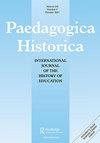国家的继子:1800-1845年,法国军队中教育文工团的孩子。
IF 0.3
4区 教育学
Q4 EDUCATION & EDUCATIONAL RESEARCH
引用次数: 0
摘要
本文章由计算机程序翻译,如有差异,请以英文原文为准。
Stepchildren of the state: educating enfants de troupe in the French army, 1800-1845.
Throughout the 19th century, the French army supported and educated the sons of common soldiers known as “enfants de troupe”. The army's chief objectives were to tap this manpower pool for its own uses and to boost army morale by showing that it cared for the families of its defenders. However, during the period 1830‐1845, many officers became increasingly concerned with caring for the children's well‐being, and with providing them with an education beyond practical military training. This concern paralleled similar civilian movements to limit child labor and institute universal primary education, yet the differing cultures and needs of the army and of civilian societies resulted in different approaches to education. Ultimately, the army chose to embrace mutual education with a heavy emphasis on practical training in administrative duties. While officers placed increased emphasis on academic training and on the physical well‐being of the children, the army continued to exploit “enfants de troupe” as “child labor.”
求助全文
通过发布文献求助,成功后即可免费获取论文全文。
去求助
来源期刊

PAEDAGOGICA HISTORICA
Multiple-
CiteScore
0.90
自引率
40.00%
发文量
72
期刊介绍:
"Paedagogica Historica is undoubtedly the leading journal in the field. In contrast to a series of national journals for the history of education, Paedagogica Historica is the most international one." A trilingual journal with European roots, Paedagogica Historica discusses global education issues from an historical perspective. Topics include: •Childhood and Youth •Comparative and International Education •Cultural and social policy •Curriculum •Education reform •Historiography •Schooling •Teachers •Textbooks •Theory and Methodology •The urban and rural school environment •Women and gender issues in Education
 求助内容:
求助内容: 应助结果提醒方式:
应助结果提醒方式:


